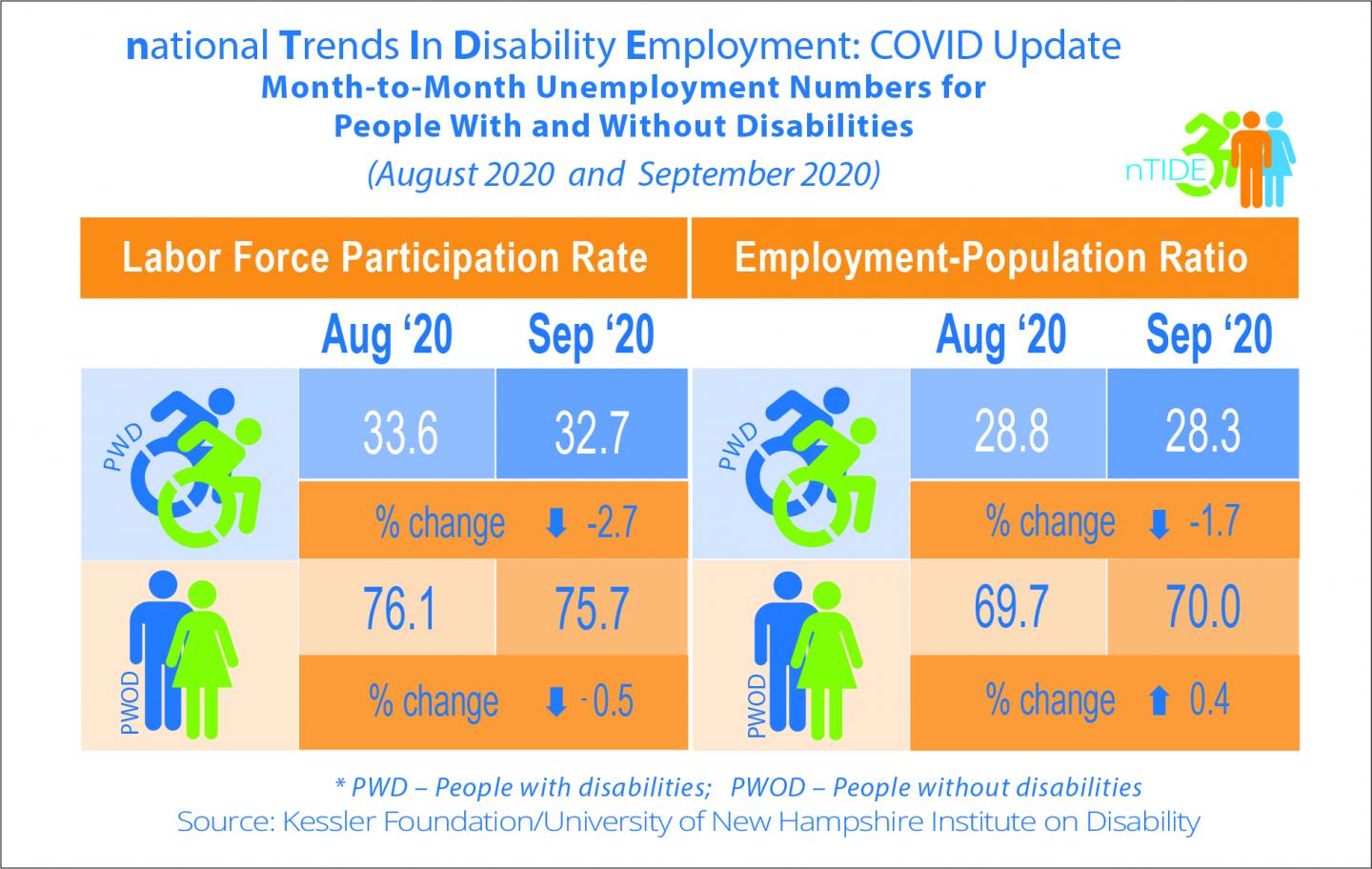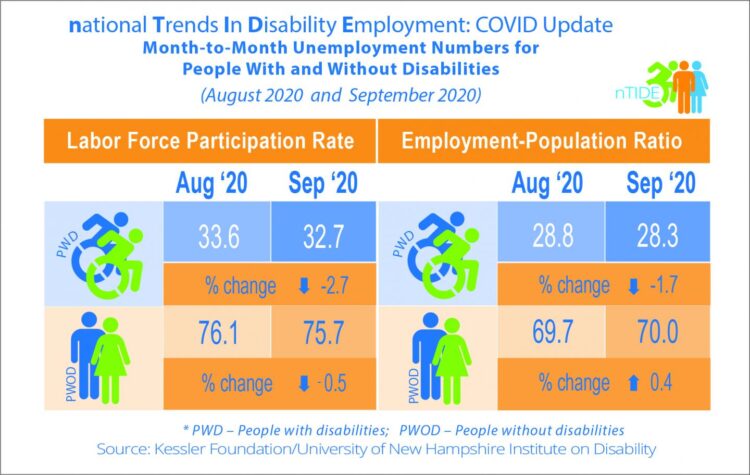Kessler Foundation and University of New Hampshire nTIDE Report–featuring more on the 2020 Kessler Foundation National Employment and Disability Survey and the experiences of college graduates with disabilities who came of age under the ADA

Credit: Kessler Foundation
East Hanover, NJ – October 2, 2020 – The downshift in the September job numbers sparks concerns about employment prospects for Americans with and without disabilities, according to today’s National Trends in Disability Employment – Monthly Update (nTIDE), issued by Kessler Foundation and the University of New Hampshire’s Institute on Disability (UNH-IOD). The declines in the economic indicators reflect the impact of the COVID pandemic on the ability of workers to stay engaged in the labor market.
nTIDE COVID Update (month-to-month comparison)
In the Bureau of Labor Statistics (BLS) Jobs Report released Friday, the employment-to-population ratio for working-age people with disabilities decreased from 28.8 percent in August to 28.3 percent in September (down 1.7 percent or 0.5 percentage points). For working-age people without disabilities, the employment-to-population ratio increased from 69.7 percent in August to 70 percent in September (up 0.4 percent or 0.3 percentage points). The employment-to-population ratio, a key indicator, reflects the percentage of people who are working relative to the total population (the number of people working divided by the number of people in the total population multiplied by 100).
“August’s modest gains in the employment-to-population ratio for people with and without disabilities have been lost due to the continued effects of COVID-19,” said John O’Neill, PhD, director of employment and disability research at Kessler Foundation. “And for next month’s nTIDE report,” he added, “we are likely to see these declines continue as more workers move from furlough to termination.”
The labor force participation rate for working-age people with disabilities decreased from 33.6 percent in August to 32.7 percent in September 2020 (down 2.7 percent or 0.9 percentage points). For working-age people without disabilities, the labor force participation rate also decreased from 76.1 percent in August to 75.7 percent in September 2020 (down 0.5 percent or 0.4 percentage points). The labor force participation rate is the percentage of the population that is working, not working and on temporary layoff, or not working and actively looking for work.
“The labor force participation rate is a bell-weather of the long-term employment prospects of people with disabilities,” cautioned economist Andrew Houtenville, PhD, research director of the University of New Hampshire’s Institute on Disability. “September’s decline in this indicator suggests that people with disabilities are leaving the labor market–they are no longer on furlough or actively looking for work. As the pandemic continues and more workers are permanently let go, we are likely to see further declines in the labor force participation rate.”
nTIDE COVID Update – Friday, October 23 at 12:00 pm Eastern
Stay tuned for more about the employment of people with disabilities as we follow the impact of COVID-19 and look at the numbers in more detail.
Traditional nTIDE Numbers (comparison to the same time last year)
The employment-to-population ratio for working-age people with disabilities decreased from 31.4 percent in September 2019 to 28.3 percent in September 2020 (down 9.9 percent or 3.1 percentage points). For working-age people without disabilities, the employment-to-population ratio also decreased from 74.9 percent in September 2019 to 70 percent in September 2020 (down 6.5 percent or 4.9 percentage points).
The labor force participation rate for working-age people with disabilities decreased from 33.7 percent in September 2019 to 32.7 percent in September 2020 (down 3 percent or 1 percentage points). For working-age people without disabilities, the labor force participation rate also decreased from 77.4 percent in September 2019 to 75.7 percent in September 2020 (down 2.2 percent or 1.7 percentage points).
For reference, in September 2020, among workers ages 16-64, the 4,208,000 workers with disabilities represented 3.1 percent of the total 137,815,000 workers in the U.S.
Beyond the Numbers
In 2020, we mark 30 years of the Americans with Disabilities Act (ADA) and 75 years of celebrating October as National Disability Employment Awareness Month. To commemorate these important milestones, Kessler Foundation released the results of the first national survey of college graduates with disabilities who came of age since the passage of the ADA – the 2020 Kessler Foundation National Employment and Disability Survey: Recent College Graduates.
The Survey, which was commissioned by Kessler Foundation and implemented by the University of New Hampshire Institute on Disability (UNH-IOD), showed that recent college graduates with disabilities were as likely to be employed as their peers without disabilities, with 90 percent of each group holding jobs after college. “This Survey clearly suggests that higher education pays off for people with disabilities,” said Dr. Phillips, research assistant professor at UNH-IOD and project director for the Survey. For all recent graduates, preparing for careers by engaging in internships, paid employment, and career counseling services correlated positively with working after graduation. “Students with disabilities were just as likely to engage in these activities, and benefit from them, as their peers without disabilities,” reported Dr. Phillips.
The Survey findings counter traditional viewpoints about the potential for young people with disabilities. “Our surveys give voice to people with disabilities, dispelling many of the myths about their participation in higher education and the workplace,” asserted Katz, senior VP of the Center for Grants and Communications at Kessler Foundation. “With our 2020 survey, we lay to rest more myths about people with disabilities – that college isn’t a good choice for them, that they cannot perform as well as their peers, that they won’t find jobs after graduation.” The Survey can also guide decision making made more complicated by the COVID economy. “Now we can be confident in advising high school students with disabilities to pursue higher education,” said Katz, “even in an environment of widespread unemployment.”
Bryce Stanley, BA, MS, PhD candidate, and research assistant at the University of New Hampshire shared how his experiences compared with the survey’s main findings. Stanley was encouraged when the survey showed that peers with disabilities were striving to work and transitioning to jobs, but cautioned that disparities remain in job quality (e.g., earnings, hours working) between college graduates with and without disabilities.
Dr. Phillips continues to dig deeper into the survey results, seeking better ways to support and advise youth with disabilities, their families, and educators. “Clearly, there is room to build on the gains achieved since the ADA,” she concluded, “and improve the educational experiences and employment outcomes of people with disabilities.”
###
Ask Questions about Disability and Employment
Each nTIDDE release is followed by a noon nTIDE Lunch & Learn webinar at noon ET. series. This live broadcast, hosted via Zoom Webinar, offers attendees Q&A on the latest nTIDE findings, provides news and updates from the field, as well as invited panelists to discuss current disability-related findings and events. On October 2, Kimberly Phillips, PhD, and Bryce Stanley, MS, join Drs. Houtenville and O’Neill, and Denise Rozell, Policy Strategist at AUCD. Join live or watch the recordings at: ResearchonDisability.org/nTIDE.
NOTE: The statistics in the nTIDE are based on Bureau of Labor Statistics numbers but are not identical. They are customized by UNH to combine the statistics for men and women of working age (16 to 64). nTIDE is funded by Kessler Foundation.
About Kessler Foundation
Kessler Foundation, a major nonprofit organization in the field of disability, is a global leader in rehabilitation research that seeks to improve cognition, mobility, and long-term outcomes — including employment — for people with neurological disabilities caused by diseases and injuries of the brain and spinal cord. Kessler Foundation leads the nation in funding innovative programs that expand opportunities for employment for people with disabilities. For more information, visit KesslerFoundation.org.
About the Institute on Disability at the University of New Hampshire
The Institute on Disability (IOD) at the University of New Hampshire (UNH) was established in 1987 to provide a coherent university-based focus for the improvement of knowledge, policies, and practices related to the lives of persons with disabilities and their families. For information on the NIDILRR-funded Employment Policy and Measurement Rehabilitation Research and Training Center, visit ResearchonDisability.org.
For more information, or to interview an expert, contact:
Carolann Murphy, 973.324.8
Media Contact
Carolann Murphy
[email protected]





